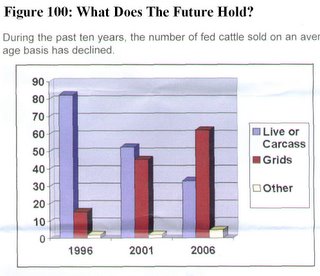Beef Market Advisor
Sunday, November 20, 2005
Consider A Radical Strategy
Consider A Radical Strategy
Market analysts say there is little doubt that American ranchers are expanding their herds. Exceptionally strong prices the past three years have increased ranch profitability and encouraged expansion. That expansion has boosted demand for replacement females and helped increase prices for females in every category.
Strong female prices are certainly welcome in ranch country, but if you're one who likes to manage your business proactively rather than reactively, consider this radical strategy: sell your cows. All of them.
Market analysts believe the peak in female prices for this cattle cycle will occur sometime during the next two to four months. That's due to re-cord or near record calf prices the past two years, and the fact a lot of ranchers have plenty of feed go-ing into this winter. That has helped in-crease demand for cows and heifers in every category.
Strong female prices help increase your net worth, and they look good on that balance sheet ,you provide the bank. But what if you sold those cows now, near the mar-ket's peak, and took the winter off? Might you buy back similar cows at
a later date at a lower cost? History, and a lot of market analysts, says you can.
USDA's cattle inventory report, issued last January, confirmed that ranchers began the expansion phase of the cattle cycle in 2004. Beef cow numbers were up about 200,000 head to 33.06 million, and replace-ment heifers were up more than 4 percent to total 5.75 million head. Combined, those increases in the breeding herd amounted to more than 400,000 on Jan. l, 2005.
Recent data suggest that expansion continues this year. Through the end of September, heifer slaugh-
ter totaled just 85 percent of' steer slaughter in USDA slaughter re-ports. At the same time last year, heifer slaughter equaled 93 percent of steer slaughter. Market analysts such as Kansas State University economist James Mintert say that's an indication ranchers are sending more heifers to the breeding herd than the feedlot.
More females in the herd, ultimately, will mean more cattle on feed, more beef produced and lower prices. But the cattle cycle is relatively drawn out. Most of the past cycles have taken 10 or 11 years to go from production peak to production peak. That means you have a little time to take action and capitalize on good prices.
Most market analysts believe the cow-calf sector will see good profits next year and probably again in 2007; After that, the expanding cow herd will begin to put more calves in the pipe-line and prices will be lower, maybe not reach-ing their low point until the end of the decade. As calf prices decline the next few years, the value of females will no doubt follow. Now would seam an excellent time to explore a few options for your operation. Sell All of them, Selling all of your cows may seem like a radical option, but it's not the only one.
Consider culling your cows deeper this fall, maybe even to the 50 percent level. Cash in your chips, retire some debt and make the winter workload a lot easier. Push a pencil on your cost savings if you eliminated half ,your feeding chores this winter.
There's no guarantee, the next few months will produce the highest prices of this cattle cycle, but the odds are good that it will produce close to the peak. And market history suggests you'll be able to buy back cows of similar quality at significantly less money in a year or two.
By Greg Henderson
Pg 50 Drovers Journal Nov 2005
posted by Dr. Harlan Hughes 2:01 PM [edit]

What does the future hold?
During the past ten years, the number of fed cattle sold on an average basis has declined. See Figure 100.
Many producers are beginning to realize they have to change fron traditional marketing to value-based marketing--not only to capture more of the value, but to keep up with the marketing shift in the industry.
With the advent of individual animal identification, the ability to market animals individually and improve profitability is here. Producers who take advantage of this tracking technology will be able to utilize the information to improve the quality and value of their cattle.
posted by Dr. Harlan Hughes 7:19 AM [edit]

